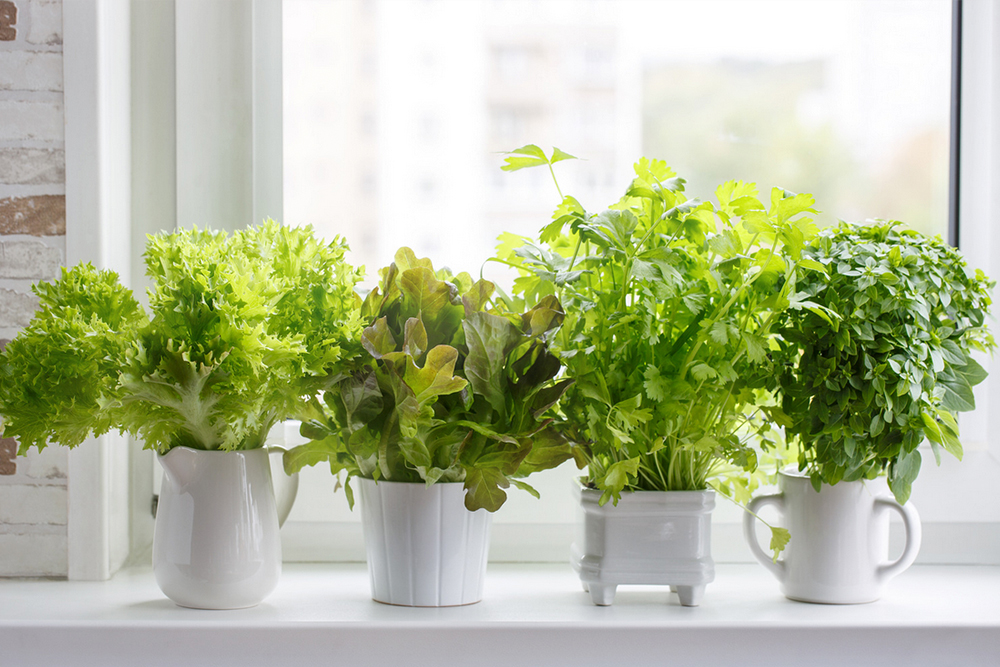
26 Mar Kitchen Gardening 101
There’s a reason everyone loves kitchen gardening! One of the greatest benefits is the greenery it adds to your space. From fresh herbs to vibrant vegetables, your window sill can transform into a budding potager that not only enhances your cooking but also purifies the air in your home. Additionally, kitchen scraps such as fruit peels, pips and seeds can be repurposed as compost to provide nutrients to your plants. This not only reduces waste but also saves money on fertilisers.
What’s even better is you can start cultivating new plants from leftover kitchen scraps as a fun and engaging way to learn about gardening. By following simple techniques such as suspending an avocado pit in a glass of water or planting individual garlic cloves in soil, you can turn food waste into new growth. This not only promotes sustainability but also helps to build a deeper connection with the food we consume.
By embracing this simple yet rewarding practice, you can enjoy a greener and more sustainable lifestyle.
HOW TO BEGIN?
While microgreens are a great option for beginners due to their ease of growth, there are also dedicated growing seed starter kits available that can make the process even easier. These kits take up very little space and require minimal effort, making them a great starting point for those who are new to gardening.
However, if you’re an ambitious gardener and have a specific area in mind for your garden, it’s important to consider how much space you’re dedicating to your potager. Once you know how much space you have, you can decide on the type of planting containers you’ll need. This can include individual pots, a stacking planter, hanging pots, or micro garden grow bags.
To make the most of your space, vertical gardens are a great option! This can involve stacking your planters or pots to maximise your growing area while keeping your space clutter-free. By thinking creatively about the space you have available, you can create a kitchen garden that is both beautiful and functional.
WHAT DO I PLANT?
With access to sunlight and fresh air, you can easily grow a variety of plants inside your home. To start, choose a few of your favourite plants that you will be excited to watch grow.
Basil is a crowd favourite and is a versatile herb that can be used in a variety of dishes such as salads, pizza, and pasta. It is also a natural mosquito repellent and requires plenty of sunlight to grow, so make sure to place it in a sunny location.
Oregano is another herb that loves sunlight and is easy to grow indoors. Rosemary, on the other hand, requires soil that is always moist until the seeds begin to sprout, so it’s best to plant it separately.
Thyme is another easy herb to grow indoors, and it loves sun and heat but needs good drainage to prevent the soil from remaining damp for too long.
If you want to grow some vegetables, tomatoes, lettuce, spinach, and sweet bell peppers are all easy to grow on any kitchen windowsill in a container or pot. Spinach is another simple one that you can grow indoors. Once you’ve planted the seeds in good soil with proper drainage, you can water them every second day in summer and once a week in winter and enjoy fresh produce all year round.
TOP TIP: Dabbing cinnamon on the roots of your plants can help prevent mould from occurring!
HOW TO USE KITCHEN SCRAPS TO GROW NEW PLANTS
Growing plants from leftover kitchen scraps is a great way to reduce food waste and have a fresh supply of herbs and vegetables at your fingertips. There are a variety of kitchen scraps that can be regrown into new plants, and here are some tips to get you started:
- Green onions/scallions: Simply place the roots of the green onions in a glass with enough water to cover them, and change the water every few days. You’ll have fresh green onions in no time.
- Carrots: Carrot tops can be regrown in a shallow dish of water, and they will develop new greens that can be used in salads or as a garnish.
- Avocado: Keep the pit from an avocado and suspend it in a glass of water with the narrow end facing down. The pit should be halfway submerged in the water, and it will sprout roots and a stem in a few weeks.
- Pineapple: Cut the top off of a pineapple, leaving about an inch of fruit attached to the leaves. Allow the cut end to dry for a day or two, then plant it in soil. Water it regularly and it will grow into a new pineapple plant.
- Garlic: Plant individual garlic cloves in soil, making sure that the pointed end is facing up. Keep the soil moist and wait for the shoots to emerge.
With a bit of patience and care, you can enjoy fresh produce and herbs from your kitchen all year round while reducing your waste and positively impacting the planet.



No Comments